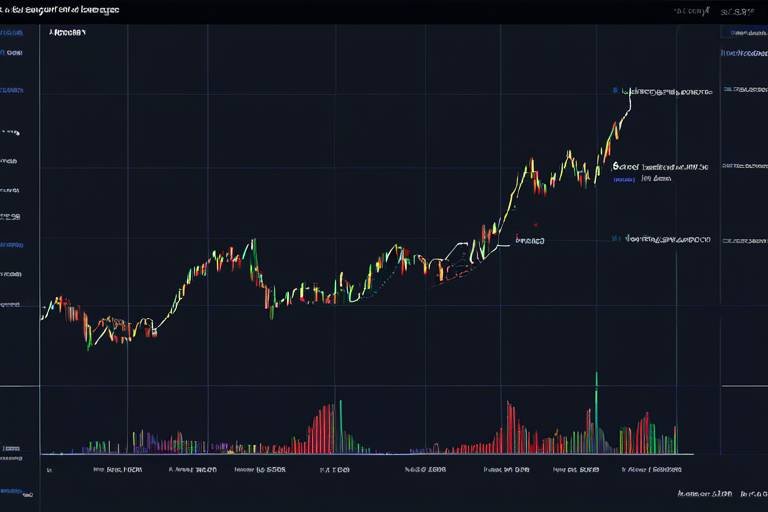How to Analyze and Trade Cryptocurrency Forks
In the ever-evolving world of cryptocurrency, forks are events that can shake up the market and create both challenges and opportunities for traders. Understanding how to analyze and trade these forks is crucial for anyone looking to make informed investment decisions. So, what exactly is a cryptocurrency fork? In simple terms, a fork occurs when there is a change in the protocol of a cryptocurrency, leading to a divergence in the blockchain. This can result in the creation of a new coin or a significant change in the existing one. As we delve deeper into the intricacies of forks, you'll discover that they can be both a blessing and a curse for investors.
When a fork is announced, it often generates a buzz in the crypto community. Traders may rush to buy or sell their assets based on their predictions about the fork's impact on prices. This is where analysis becomes key. By understanding the different types of forks and their implications, you can position yourself to capitalize on potential price movements. Are you ready to unlock the secrets of cryptocurrency forks and enhance your trading strategy? Let's dive in!
Cryptocurrency forks are significant events that can impact the market. They represent a change in the underlying software of the blockchain, leading to a split in the network. This section explains what forks are, their types, and how they influence the blockchain ecosystem. Forks can arise for various reasons, including disagreements among developers, the need for upgrades, or to address security issues. Each fork has its unique characteristics, and understanding these is essential for any trader.
There are two main types of forks: hard forks and soft forks. Each type has its implications for the blockchain and its users. Hard forks create a permanent divergence in the blockchain, resulting in two separate chains, while soft forks are backward-compatible changes that do not result in a split. Knowing the differences between these forks can help investors gauge their potential outcomes.
Hard forks are significant events that can lead to a complete change in the blockchain's trajectory. When a hard fork occurs, it results in two distinct cryptocurrencies, each with its own set of rules and community. This can lead to market volatility as traders react to the news. Notable examples of hard forks include Bitcoin Cash and Ethereum Classic, both of which emerged from contentious splits. The effects on market sentiment can be profound, often leading to a surge in trading activity.
Analyzing historical hard forks provides insights into market reactions and investor behavior. For instance, the Bitcoin Cash hard fork in 2017 led to a significant increase in trading volume and price speculation. Traders who anticipated the fork's impact were able to capitalize on the price movements, while others faced losses due to the volatility. These case studies highlight the importance of thorough analysis before making trading decisions.
While hard forks can present lucrative trading opportunities, they also come with risks. Investors must be aware of the potential for volatility and the possibility of losing funds. To mitigate these risks, it's essential to conduct thorough research and stay updated on news surrounding the fork. Understanding the community's sentiment and the technical aspects of the fork can help you make informed decisions.
On the other hand, soft forks are generally less disruptive and are designed to enhance the existing blockchain without creating a new coin. These changes are backward-compatible, meaning that non-upgraded nodes can still participate in the network. Soft forks often focus on improvements like increased security or efficiency, making them less controversial than hard forks. However, they can still impact market sentiment and trading strategies.
Identifying trading opportunities during forks requires careful analysis. Traders should look for key indicators such as changes in trading volume, social media sentiment, and historical price patterns. Utilizing tools like technical analysis can provide insights into potential price movements. By understanding what drives the market during these events, you can position yourself for success.
Understanding market sentiment is crucial for making informed trading decisions. Traders can gauge sentiment through social media platforms, news outlets, and community discussions. A sudden increase in mentions of a particular cryptocurrency can indicate growing interest or concern, which may affect price movements. By staying attuned to these discussions, you can make timely decisions.
Technical analysis plays a vital role in trading forks. Traders can use various techniques and indicators, such as moving averages, RSI, and MACD, to predict price movements effectively. These tools can help you identify trends and potential reversal points, enabling you to make more informed trading decisions. Remember, the key is to combine technical analysis with fundamental insights to create a robust trading strategy.
- What is a cryptocurrency fork? A cryptocurrency fork is a change in the protocol of a blockchain, leading to a split or divergence in the network.
- What are the types of forks? The two main types of forks are hard forks, which create a new chain, and soft forks, which are backward-compatible changes.
- How can I analyze forks for trading opportunities? Traders can analyze forks by assessing market sentiment, trading volume, and using technical analysis techniques.
- What risks are associated with hard forks? Hard forks can lead to market volatility and potential loss of funds, so thorough research is essential.

Understanding Cryptocurrency Forks
Cryptocurrency forks are significant events in the blockchain ecosystem that can lead to substantial changes in the way a cryptocurrency operates. At their core, forks represent a divergence in the blockchain's code, which can result in the creation of a new cryptocurrency or the modification of an existing one. This can happen for various reasons, including the need for upgrades, changes in governance, or community disagreements. Understanding these forks is crucial for anyone looking to navigate the sometimes turbulent waters of the cryptocurrency market.
Essentially, a fork occurs when there is a split in the blockchain, leading to two separate paths. This can be compared to a river that forks into two streams; each stream may take a different course, influenced by its own set of factors. The implications of these forks can be far-reaching, affecting everything from the price of the cryptocurrency to its overall adoption and usage. As such, investors and developers alike must stay informed about upcoming forks to make educated decisions.
There are two primary types of cryptocurrency forks: hard forks and soft forks. Each type has its own characteristics and consequences. Hard forks result in a permanent split of the blockchain, creating two distinct chains that may operate independently of each other. This often leads to the creation of a new cryptocurrency, as seen with Bitcoin Cash, which emerged from a hard fork of Bitcoin in 2017. On the other hand, soft forks are backward-compatible changes that allow for modifications without splitting the blockchain. This means that users can continue to use the original chain without any disruption, as seen with Bitcoin's SegWit upgrade.
In the world of cryptocurrency, forks can be both a blessing and a curse. They can present lucrative trading opportunities, but they also carry inherent risks. For instance, a hard fork can lead to increased volatility as traders react to the news, while a soft fork may go largely unnoticed, resulting in minimal price movement. Understanding the nuances of each type of fork is essential for anyone looking to capitalize on these events.
To further illustrate the impact of forks, let's take a look at a few key statistics:
| Fork Type | Impact on Market | Examples |
|---|---|---|
| Hard Fork | Can create new cryptocurrencies, often leading to price volatility | Bitcoin Cash, Ethereum Classic |
| Soft Fork | Typically less disruptive, may improve existing cryptocurrency | Bitcoin SegWit, Ethereum's Constantinople |
In conclusion, understanding cryptocurrency forks is crucial for anyone involved in the crypto market. They can shape the future of a cryptocurrency and create opportunities for traders and investors. By keeping an eye on upcoming forks and understanding their implications, you can position yourself to take advantage of these significant events in the blockchain world.

Types of Forks
When diving into the world of cryptocurrency, it's essential to understand that not all forks are created equal. Forks are essentially updates or changes to a blockchain, and they come in two primary flavors: hard forks and soft forks. Each type has its own characteristics, implications, and potential outcomes that can significantly affect both the technology and the market. Understanding these distinctions can help investors and developers navigate the often turbulent waters of the crypto ecosystem.
A hard fork is a radical change to the protocol that makes previously invalid blocks valid, or vice versa. This type of fork creates a permanent divergence in the blockchain, resulting in two separate chains. Think of it like a road splitting into two paths; once you choose one, you can’t go back. Hard forks often occur when there is a disagreement within the community about the direction of the project. For example, the infamous Bitcoin Cash fork from Bitcoin was a result of differing opinions on block size and transaction speed. This split opened up new opportunities for traders, but it also introduced significant volatility.
On the other hand, a soft fork is a more subtle change that is backward-compatible. This means that even if you don’t upgrade to the new version of the software, you can still interact with the network. Soft forks are like adding a new lane to a highway—traffic can still flow in the original lanes while the new lane is being used. These changes are often less controversial and can be implemented without creating a separate blockchain. A prime example of a soft fork is the Segregated Witness (SegWit) update for Bitcoin, which aimed to improve transaction capacity without splitting the chain.
To summarize the differences between hard and soft forks, consider the following table:
| Type of Fork | Definition | Impact on Blockchain | Community Response |
|---|---|---|---|
| Hard Fork | Permanent divergence creating two separate chains | New blockchain is formed | Can be controversial and lead to community splits |
| Soft Fork | Backward-compatible changes to the existing blockchain | Single blockchain remains intact | Generally less contentious and more widely accepted |
Understanding these two types of forks is crucial for anyone looking to invest in or develop cryptocurrency projects. The implications of a fork can vary widely, affecting everything from market sentiment to the technology itself. As an investor, recognizing the signs of an impending fork and understanding its nature can provide you with a significant edge in making informed trading decisions.
In conclusion, whether you're a trader, developer, or just a curious observer, grasping the nuances of hard and soft forks will enhance your ability to navigate the complex landscape of cryptocurrency. By staying informed about these events, you can better position yourself to capitalize on the opportunities they present while also mitigating the risks involved.

Hard Forks Explained
When we talk about hard forks, we're diving into one of the most intriguing aspects of the cryptocurrency world. A hard fork occurs when there is a significant change in a blockchain's protocol, leading to a permanent divergence from the original version of the blockchain. This means that the network splits into two separate chains, each with its own set of rules and protocols. Imagine it like a road that forks into two paths: one continues straight while the other veers off in a different direction. This split can happen for various reasons, including disagreements within the community about the direction of the project, the need for updates, or even to address security vulnerabilities.
One of the most famous examples of a hard fork is the split between Bitcoin and Bitcoin Cash in 2017. This event was primarily driven by debates over scaling solutions and transaction speeds. Bitcoin Cash aimed to increase the block size to allow more transactions to be processed at once, while Bitcoin retained its original protocol. Such forks can create a buzz in the market, leading to increased trading activity and price volatility. Investors often find themselves at a crossroads, trying to decide which path to follow. This can lead to significant price movements, both upward and downward, depending on the sentiment surrounding the fork.
It's important to note that hard forks can also result in the creation of new cryptocurrencies. When a hard fork occurs, holders of the original cryptocurrency typically receive an equivalent amount of the new token on the new chain. This can create opportunities for investors, but it also introduces complexities. For instance, if you held Bitcoin during the Bitcoin Cash fork, you suddenly found yourself with both Bitcoin and Bitcoin Cash—two separate assets that could behave differently in the market.
To better understand the impact of hard forks, let's take a look at a few notable case studies:
| Hard Fork | Date | Original Coin | New Coin | Market Impact |
|---|---|---|---|---|
| Bitcoin Cash | August 1, 2017 | Bitcoin (BTC) | Bitcoin Cash (BCH) | Increased volatility, BCH initially surged |
| Ethereum Classic | July 20, 2016 | Ethereum (ETH) | Ethereum Classic (ETC) | Created two distinct communities, price fluctuations |
These forks can stir up a whirlwind of emotions among traders and investors. While some may view them as opportunities to capitalize on the new asset, others may feel anxious about potential losses. It's crucial to stay informed and understand the implications of each hard fork. The landscape can change rapidly, and the key to navigating these waters is to remain vigilant and analytical.
In summary, hard forks are not just technical events; they are pivotal moments that can reshape the cryptocurrency market. They can lead to the creation of new opportunities, but they also come with their fair share of risks. As an investor, understanding the mechanics behind hard forks and their potential outcomes is essential for making informed decisions in this ever-evolving space.

Case Studies of Hard Forks
When it comes to understanding the implications of hard forks in the cryptocurrency world, analyzing case studies can provide invaluable insights. One of the most significant examples is the Bitcoin Cash (BCH) hard fork from Bitcoin (BTC) in August 2017. This event was a result of disagreements within the Bitcoin community regarding scalability solutions. The split led to the creation of a new cryptocurrency, Bitcoin Cash, which aimed to increase block size to accommodate more transactions per second. The immediate aftermath saw a surge in interest and trading volume for both BTC and BCH, showcasing how forks can create new opportunities and volatility in the market.
Another notable example is the Ethereum Classic (ETC) hard fork from Ethereum (ETH) in July 2016. This fork was initiated in response to the infamous DAO hack, where a significant amount of ETH was stolen. The Ethereum community decided to implement a hard fork to reverse the hack, resulting in the creation of Ethereum Classic, which continued on the original chain. This case exemplifies how hard forks can stem from ethical and governance issues within a blockchain community, and it highlights the division it can create among investors. Following the fork, both ETH and ETC have developed their unique ecosystems, leading to different use cases and market perceptions.
To further understand the effects of these forks, we can look at a comparison table that outlines key metrics and outcomes:
| Case Study | Original Coin | Forked Coin | Date | Market Reaction |
|---|---|---|---|---|
| Bitcoin Cash | Bitcoin (BTC) | Bitcoin Cash (BCH) | August 1, 2017 | Increased trading volume and price volatility for both coins |
| Ethereum Classic | Ethereum (ETH) | Ethereum Classic (ETC) | July 20, 2016 | Division in community sentiment; ETH surged, while ETC remained stable |
These case studies illustrate that hard forks can lead to significant shifts in market dynamics. Investors often react with a mix of excitement and caution, leading to fluctuating prices and trading strategies. It's crucial to monitor not only the technical aspects of the fork but also the community sentiment and the broader implications for the cryptocurrency ecosystem.
In conclusion, studying historical hard forks provides a roadmap for navigating future events in the crypto space. The lessons learned from Bitcoin Cash and Ethereum Classic emphasize the importance of understanding the motivations behind a fork, the community's reaction, and the potential for new investment opportunities that arise. As the cryptocurrency landscape continues to evolve, staying informed about past forks can equip investors with the knowledge needed to make strategic decisions in a rapidly changing market.

Risks Associated with Hard Forks
When it comes to hard forks, the excitement can often overshadow the inherent risks that accompany these events. While hard forks can lead to new opportunities and potential profits, they also bring a set of challenges that every investor should be aware of. One of the most significant risks is volatility. Following a hard fork, the value of the original cryptocurrency can fluctuate wildly, sometimes leading to substantial losses for unprepared traders. Just like a roller coaster, the ride can be thrilling but also terrifying if you're not strapped in properly.
Another risk to consider is the potential loss of funds. In the chaos surrounding a hard fork, there can be confusion regarding which chain is the "real" one, leading to investors inadvertently sending their assets to the wrong address or chain. This scenario can be likened to navigating a maze without a map; one wrong turn, and you could find yourself lost and without your funds. Additionally, the technological complexities behind forks can lead to unforeseen issues, such as bugs and security vulnerabilities, which may expose investors to further risks.
Moreover, the community split that often accompanies a hard fork can create a rift among users and developers. This division can lead to uncertainty about the future of both chains, making it difficult for investors to gauge which direction to take. In such situations, it's not just about choosing a side; it's about understanding the implications of that choice. The sentiment within the community can greatly influence the success of each chain, and being on the wrong side of that sentiment can be detrimental.
To summarize, here are some key risks associated with hard forks:
- Volatility: Prices can swing dramatically post-fork.
- Loss of funds: Sending assets to the wrong chain can result in permanent loss.
- Technological issues: Bugs and vulnerabilities may arise, impacting security.
- Community division: Splits can create uncertainty and affect market sentiment.
In light of these risks, it’s essential for investors to conduct thorough research and stay informed about the developments surrounding any upcoming hard forks. Just like preparing for a storm, being proactive can help mitigate the impact of these risks, allowing you to navigate the turbulent waters of the cryptocurrency market more safely.
Q1: What is a hard fork?
A hard fork is a significant change to the blockchain protocol that results in the creation of a new cryptocurrency, diverging from the original chain.
Q2: How can I protect my investments during a hard fork?
Stay informed about the developments, use secure wallets, and consider keeping your assets on exchanges that support the fork.
Q3: Can hard forks lead to losses?
Yes, hard forks can create volatility and uncertainty, leading to potential losses for investors who are not cautious.
Q4: How do I know which chain to invest in after a hard fork?
Research community sentiment, technological developments, and potential use cases for both chains to make an informed decision.

Soft Forks Explained
Soft forks are fascinating events in the world of blockchain technology, serving as a way to implement changes without creating a permanent divergence in the blockchain. Unlike hard forks, which split the blockchain into two separate chains, soft forks are backward-compatible. This means that the new rules introduced by the soft fork can be adopted by nodes that have not upgraded, allowing them to still communicate within the same network. Imagine it like a software update that enhances functionality without forcing everyone to jump on a new version; it’s a more seamless transition.
One of the key aspects of soft forks is that they often aim to improve security or add new features without disrupting the existing ecosystem. For instance, a soft fork might tighten the rules of a blockchain to prevent spam transactions or enhance privacy features. Since these changes don't require every participant in the network to upgrade, they tend to be less controversial than hard forks. However, they do require a significant level of consensus among users for the changes to be effective.
To illustrate how soft forks work, consider the Bitcoin network. A notable example is the BIP 66 (Bitcoin Improvement Proposal 66), which enforced stricter rules regarding transaction signatures. This soft fork was implemented smoothly, as it did not require all miners to upgrade immediately. Instead, those who did update their software could still interact with those who hadn’t, thus maintaining network integrity. This flexibility is one of the reasons soft forks are often preferred for implementing changes in the blockchain.
However, it's important to note that while soft forks may seem less risky, they are not without their challenges. If a significant number of nodes refuse to upgrade, the network could face issues such as reduced security or inefficiencies. Therefore, achieving consensus is crucial. In the world of cryptocurrency, where community sentiment can shift rapidly, understanding the implications of a soft fork can be the difference between a successful upgrade and a chaotic fallout.
In conclusion, soft forks represent an essential mechanism for evolving blockchain technology. They allow for enhancements and improvements while maintaining network cohesion. As the cryptocurrency landscape continues to evolve, keeping an eye on soft forks and their implications will be vital for investors and developers alike. Embracing these changes can lead to exciting opportunities, but it also requires a keen understanding of the underlying dynamics at play.
- What is the main difference between hard forks and soft forks?
Hard forks create a permanent split in the blockchain, resulting in two separate chains, while soft forks are backward-compatible and do not require all nodes to upgrade. - Can a soft fork be reversed?
Once a soft fork is implemented, it cannot be reversed in the traditional sense. However, if the community disagrees with the changes, they can propose another soft fork or even a hard fork. - How do soft forks affect cryptocurrency prices?
The impact on prices can vary based on community sentiment and the perceived benefits of the changes. Generally, positive sentiment can lead to price increases, while negative reactions can cause declines.

Analyzing Forks for Trading Opportunities
When it comes to trading cryptocurrency forks, the stakes are high, and the rewards can be even higher. Understanding how to analyze these forks is crucial for anyone looking to capitalize on the potential price movements they can trigger. But how do you identify the right trading opportunities amidst the chaos? It all starts with a solid analysis strategy.
First and foremost, you need to keep your ear to the ground. The crypto community is incredibly vocal, especially during fork events. Monitoring social media platforms, crypto forums, and news outlets can provide invaluable insights into market sentiment. Are people excited about the new fork? Are there concerns about its viability? By gauging the overall mood, you can better predict how the market might react.
Next, you should consider utilizing technical analysis. This involves examining price charts and identifying patterns that may indicate future movements. Key indicators like moving averages, Relative Strength Index (RSI), and Bollinger Bands can help you make informed decisions. For instance, if you notice a significant increase in trading volume leading up to a fork, it could signal a bullish trend. Conversely, a sudden drop in volume might suggest caution.
To illustrate this, let’s take a look at a simple table that outlines some key indicators you might use:
| Indicator | Description | Implication |
|---|---|---|
| Moving Average | Averages the price over a specific period. | Helps identify the trend direction. |
| RSI | Measures the speed and change of price movements. | Indicates overbought or oversold conditions. |
| Bollinger Bands | Shows volatility and price levels. | Can signal potential price reversals. |
Moreover, keeping an eye on the development teams behind the forks is essential. Are they reputable? What’s their track record? A strong team can often lead to a successful fork, while a questionable one might raise red flags. Engaging with the community and following updates can help you assess the credibility of the teams involved.
Finally, remember that while forks can present lucrative opportunities, they also come with risks. Volatility is a common trait during these events, and prices can swing wildly in either direction. It’s crucial to have a risk management strategy in place. Setting stop-loss orders and diversifying your investments can help mitigate potential losses.
In summary, analyzing forks for trading opportunities requires a multi-faceted approach. By combining market sentiment analysis, technical indicators, and a thorough understanding of the teams behind the forks, you can position yourself to make informed trading decisions. So, as you navigate the unpredictable waters of cryptocurrency forks, keep these strategies in mind to enhance your trading game!
- What is a cryptocurrency fork? A cryptocurrency fork is an event where a blockchain diverges into two separate chains, which can occur due to changes in protocol or disagreements among developers.
- What is the difference between a hard fork and a soft fork? A hard fork creates a permanent divergence in the blockchain, resulting in two separate chains, while a soft fork is a backward-compatible change that allows the original chain to continue operating.
- How can I profit from a cryptocurrency fork? To profit from a fork, traders should analyze market sentiment, utilize technical analysis, and stay informed about the developments surrounding the fork.
- Are there risks involved with trading during forks? Yes, trading during forks can be risky due to high volatility, potential loss of funds, and uncertainty surrounding the fork's success.

Market Sentiment Analysis
When it comes to trading cryptocurrencies, understanding market sentiment can be your secret weapon. Think of it as the pulse of the crypto community—it's not just about numbers on a chart; it's about the feelings, opinions, and collective mood of traders and investors. So, how do you tap into this elusive sentiment? Well, it's all about knowing where to look and how to interpret the signals.
Social media platforms like Twitter and Reddit are treasure troves of sentiment data. By monitoring discussions and trending topics, you can gauge what the community is excited or worried about. For instance, if you notice a surge in tweets about a particular fork, it could indicate rising interest, which often translates to increased trading activity. Conversely, if the chatter turns negative, it might be a red flag. Tools like Sentiment Analysis can help quantify this data, providing a clearer picture of how the market feels.
Moreover, news articles and press releases can significantly impact sentiment. A positive announcement regarding a fork can lead to a bullish trend, while negative news can trigger panic selling. It's essential to stay updated with reliable news sources and follow influential figures in the cryptocurrency space. By doing this, you can position yourself ahead of the curve, making informed decisions based on the prevailing sentiment.
Another useful method for analyzing market sentiment is through community discussions. Engaging with forums and chat groups can provide insights into what the average investor is thinking. Are they optimistic about a new fork, or are they skeptical? By participating in these discussions, you not only gather information but also build a network of like-minded traders who can share their perspectives.
To visualize market sentiment, consider creating a simple table that summarizes key indicators:
| Indicator | Description | Impact on Sentiment |
|---|---|---|
| Twitter Mentions | Number of times a cryptocurrency is mentioned on Twitter | High mentions can indicate bullish sentiment |
| Reddit Posts | Volume of posts related to a specific fork | Increased posts may signify growing interest or concern |
| News Articles | Positive or negative reports about the cryptocurrency | Positive news boosts sentiment; negative news can lead to panic |
Ultimately, understanding market sentiment is about connecting the dots between various data points. It's not just about what you see on the surface; it's about interpreting the underlying emotions that drive market behavior. By keeping your finger on the pulse of market sentiment, you can make more informed trading decisions, potentially capitalizing on opportunities that others might overlook.
- What is market sentiment in cryptocurrency trading? Market sentiment refers to the overall attitude of investors towards a particular cryptocurrency, often influenced by news, social media, and community discussions.
- How can I analyze market sentiment? You can analyze market sentiment by monitoring social media platforms, news articles, and engaging in community discussions to gauge the mood of investors.
- Why is market sentiment important for trading? Understanding market sentiment helps traders anticipate price movements and make informed decisions based on collective investor behavior.

Technical Analysis Techniques
When it comes to trading cryptocurrency forks, mastering technical analysis is like having a secret weapon in your back pocket. It allows you to predict price movements based on historical data, helping you make informed decisions during those critical moments when a fork is announced. But what exactly should you focus on? Let’s dive into some essential techniques that can guide your trading strategy.
First up, we have trend analysis. This technique involves examining price charts to identify the direction of the market. Are prices trending upwards, downwards, or moving sideways? By spotting these trends early, you can position yourself to capitalize on potential gains. For instance, if a hard fork is anticipated and the price begins to rally in the weeks leading up to it, this could signal a strong buying opportunity.
Next, let’s talk about support and resistance levels. These are critical price points where the cryptocurrency tends to stop and reverse its direction. Support levels are where the price tends to bounce back up, while resistance levels are where it tends to fall back down. By identifying these levels on your charts, you can set strategic entry and exit points. For example, if the price of a cryptocurrency is approaching a strong resistance level right before a fork, it might be wise to hold off on buying until you see if it breaks through.
Another important technique is the use of moving averages. This tool helps smooth out price data over a specific period, allowing you to see the overall trend more clearly. The 50-day moving average and the 200-day moving average are particularly popular among traders. When the shorter moving average crosses above the longer one, it’s often seen as a bullish signal, suggesting that it might be time to buy. Conversely, if the shorter moving average crosses below the longer one, it could indicate a bearish trend, signaling a potential sell.
Furthermore, volume analysis is crucial in understanding the strength of a price movement. High trading volume during a price increase typically indicates strong interest and can confirm the trend. Conversely, if prices rise but volume is low, that could be a warning sign that the trend may not be sustainable. By keeping an eye on volume, you can better gauge whether a price movement is likely to continue or reverse.
Lastly, don't overlook the power of chart patterns. Patterns such as head and shoulders, triangles, and flags can provide valuable insights into future price movements. For instance, a bullish flag pattern may suggest that after a brief consolidation period, the price is likely to break out to the upside. Recognizing these patterns can give you an edge in timing your trades effectively.
In summary, employing a combination of these technical analysis techniques can significantly enhance your trading strategy during cryptocurrency forks. By understanding market trends, support and resistance levels, moving averages, volume, and chart patterns, you’ll be better equipped to navigate the often volatile waters of the crypto market. Remember, though, that no analysis is foolproof. Always consider the broader market context and remain adaptable to changes.
- What is a cryptocurrency fork? A cryptocurrency fork is an event where a blockchain diverges into two separate chains, often resulting in the creation of a new cryptocurrency.
- How can I prepare for a hard fork? Stay informed about the fork details, analyze market sentiment, and consider your investment strategy based on potential price movements.
- Are there risks involved in trading during forks? Yes, forks can lead to significant volatility, which can result in both gains and losses. It's important to assess the risks before trading.
- What tools can help with technical analysis? Popular tools include trading platforms with charting capabilities, market analysis software, and community forums for sentiment analysis.
Frequently Asked Questions
- What is a cryptocurrency fork?
A cryptocurrency fork is an event where a blockchain diverges into two separate chains. This can happen due to changes in protocol or governance disagreements among developers. Essentially, it’s like a split in the road where one path continues on the original chain, while the other develops its own unique features.
- What are the different types of forks?
There are mainly two types of forks: hard forks and soft forks. Hard forks create a permanent split in the blockchain, resulting in two distinct cryptocurrencies. Soft forks, on the other hand, are backward-compatible changes that do not require all users to upgrade, allowing for a smoother transition.
- How do hard forks affect the market?
Hard forks can significantly impact market sentiment and prices. They often create uncertainty, leading to increased volatility. For instance, when a hard fork is announced, traders might rush to buy or sell, causing price fluctuations. It's essential to analyze historical data to understand potential outcomes.
- What risks should I consider with hard forks?
Investing during a hard fork can be risky due to potential volatility and the chance of losing funds. Prices can swing dramatically, and there may be confusion about the new currency's value. To mitigate these risks, it's crucial to do thorough research and stay updated on the developments surrounding the fork.
- How do soft forks differ from hard forks?
Soft forks are less disruptive than hard forks because they are designed to be backward-compatible. This means that even if some users do not upgrade, they can still interact with the new chain. In contrast, hard forks create two separate chains that may not be compatible with each other, requiring all users to choose a side.
- What indicators should I analyze for trading during a fork?
When trading during a fork, look for indicators such as market sentiment, trading volume, and price trends. Social media discussions and news articles can also provide insights into how the community feels about the fork, which can influence trading decisions.
- How can I gauge market sentiment before a fork?
Market sentiment can be gauged by monitoring social media platforms, forums, and news outlets. Pay attention to the community's discussions and sentiments around the fork. Tools like sentiment analysis software can also help you get a clearer picture of how traders are feeling.
- What technical analysis techniques are useful for trading forks?
Some effective technical analysis techniques include trend analysis, support and resistance levels, and the use of indicators like RSI (Relative Strength Index) and MACD (Moving Average Convergence Divergence). These tools can help predict potential price movements and assist in making informed trading decisions.



















